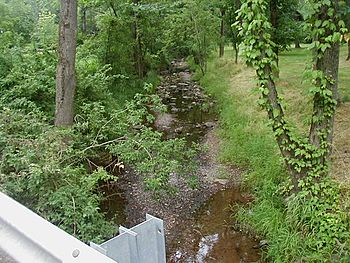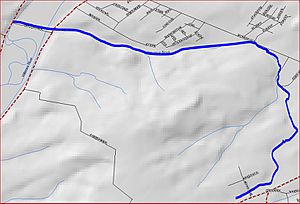Simonson Brook (New Jersey) facts for kids
Quick facts for kids Simonson Brook |
|
|---|---|

Simonson Brook crossing Canal Road, near its mouth at the Millstone River
|
|

Map of Simonson Brook
|
|
| Country | United States |
| Physical characteristics | |
| Main source | 40°24′58″N 74°35′29″W / 40.41611°N 74.59139°W |
| River mouth | 36 ft (11 m) 40°26′21″N 74°37′3″W / 40.43917°N 74.61750°W |
| Basin features | |
| Progression | Millstone River, Raritan River, Atlantic Ocean |
Simonson Brook, sometimes called Sunonson Brook, is a small stream in New Jersey. It flows into the Millstone River. You can find it in southern Franklin Park, Somerset County. The Millstone River then joins the Raritan River, which flows into the Atlantic Ocean.
Contents
Where Simonson Brook Flows
Simonson Brook begins in southwestern Franklin Park. Its starting point is near Route 27. Many smaller streams, called tributaries, feed into it from this area.
The brook flows through two neighborhoods. Then, it enters a wooded area. It passes by Bunker Hill Road and goes through the Bunker Hill Environmental Center. It also flows through the Griggstown Native Grassland Preserve. Finally, it crosses Canal Road and empties into the Millstone River.
Simonson Brook is smaller than other nearby streams. These include the Ten Mile Run and the Six Mile Run. During summer, many parts of Simonson Brook's streambeds can become dry.
How to Visit Simonson Brook
You can reach Simonson Brook by using trails in the Griggstown Native Grassland Preserve. This area is part of the Ten Mile Run Greenway. The brook also crosses several roads. These include Barbieri Court and Ridings Parkway. It is very easy to get to the brook at Canal Road.
Animals in Simonson Brook
Simonson Brook has some slow-moving areas. These spots are perfect homes for frogs. Some of its smaller streams have deep pools. These pools are home to many fish.
The Ground Around the Brook
Near where Simonson Brook joins the Millstone River, the streambed is very rocky. It is covered with broken pieces of slate. Sometimes, you can find deep pools along the streambed.
The brook gets its water from springs that flow only sometimes. This means the brook can dry up easily when it doesn't rain. Fish find it hard to live in the stream because it often dries out.
Gallery












